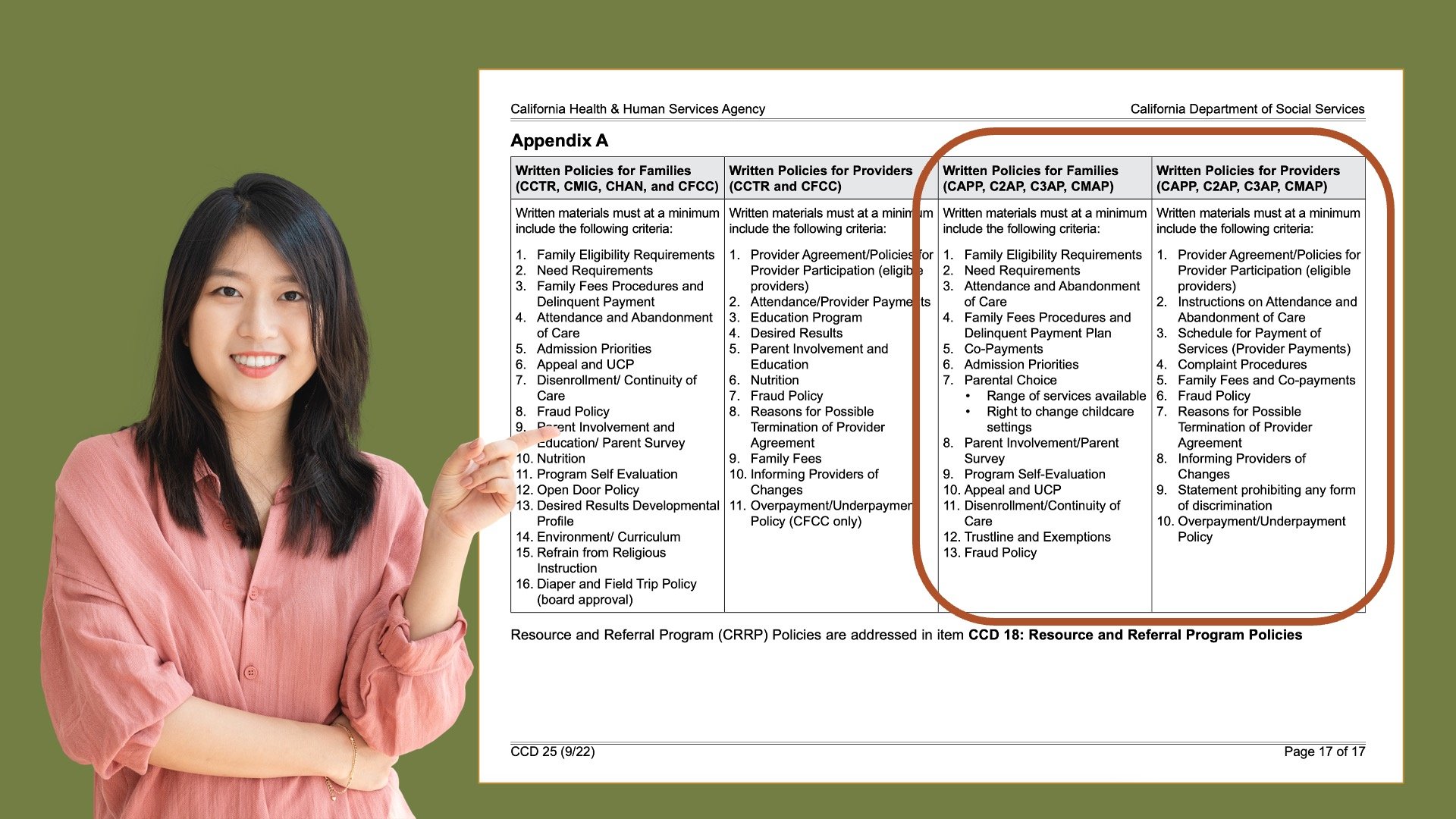Lesson
Dashboard
Lesson 1
Family Selection
Lesson 2
Family Data File
Lesson 3
Attendance
Lesson 4
Parent Involvement & Education
Lesson 5
Health & Social Services
Lesson 6
Site Licensure & License Exempt
Lesson 7
Staff-Child Ratios
Lesson 8
Environment Rating Scale
Lesson 9
Nutritional Needs
Lesson 10
Desired Results Profile & Data
Lesson 11
Qualified Staff & Director
Lesson 12
Staff Development
Lesson 13
Refrain from Religious Instruction
Lesson 14
Inventory Records
Lesson 15
Annual Evaluation Plan
Lesson 16
Fiscal
Lesson 17
CDMIS 801A & 801B Reporting
Lesson 18
Contractor Policies
Compliance Indicator
Contractors shall develop written policies and procedures. Written information shall be provided to families, providers, and the general public. The written policies and procedures may not be in conflict with law, regulations, and terms of the contract.
Regulations/Reference
CCD Program Instrument: IV. Administrative CCD 20
Title 5: 18222, 18224 & 18105 Funding Terms & Conditions: FY 2024-2025
Monitoring Review Evidence
Written Information for Families and/or Providers, as applicable
Evidence may be:
Handbooks
Postings
Webpages
Other written materials
Watch Video Lesson ❯
Sample Forms/Tools ❯
Review Sketch Pad Notes ❯
Appendix A
A family or participant handbook is commonly used to place a compilation of all required written program policies. To start, you’ll want to ensure your handbook has the minimum required policies. Compare your current parent handbook table of contents with Appendix A of the program integrity monitoring tool.
NOTE: Within the Appendix, contractors will find a list of the minimum written policies required for families.
Family Written Materials
Program Design
During a review, a reviewer will want to see your written materials for:
Parent involvement
Parent survey
Program self-evaluation
What this might look like in a program:
Include a section titled ‘Continuous Improvement’ with language that states:
“Our goal is to implement an effective annual program self-evaluation process to support continuous improvement. The process includes Assessment of the program by parents using the Parent Survey. Assessment of the program by staff and board members using the Program Integrity Monitoring Tool. Based on the results goals/action steps are developed and implemented.”
Admission Priorities
Include the process for how a family is selected for enrollment such as the program’s admission priorities.
Participation Qualifications
Include the program participation qualifications and review what items must be maintained in the family data file, such as:
Proof of residency
Health and emergency information
Court order, if child care services are impacted
Exceptional needs documentation, if applicable
Proof of family size
Eligibility Criteria
Need Criteria
Family Fee Procedures
Attendance | Absence Policy
Your written materials for attendance must include, at a minimum, the abandonment of care policy, along with how to record attendance.
Disenrollment Policy
Include the process if a family voluntarily wants to disenroll, along with the agency disenrollment policy.
Grievance| Complaint
The regulations state that contractors are required to provide parents with written policy and procedures for the various types of grievance or complaints.
What this might look like in a program:
An agency might include written grievance procedures along with parent participation policies & procedures within the participant handbook.
Information may also be provided through a parent orientation video or Powerpoint that takes new enrollees through the polices & procedures to participate.
Complete Knowledge Check ❯
After reviewing the video lesson & sketch pad notes, it’s time to check for understanding by completing a Knowledge Check. Note that Individual Knowledge Checks will conclude with a Certificate.










